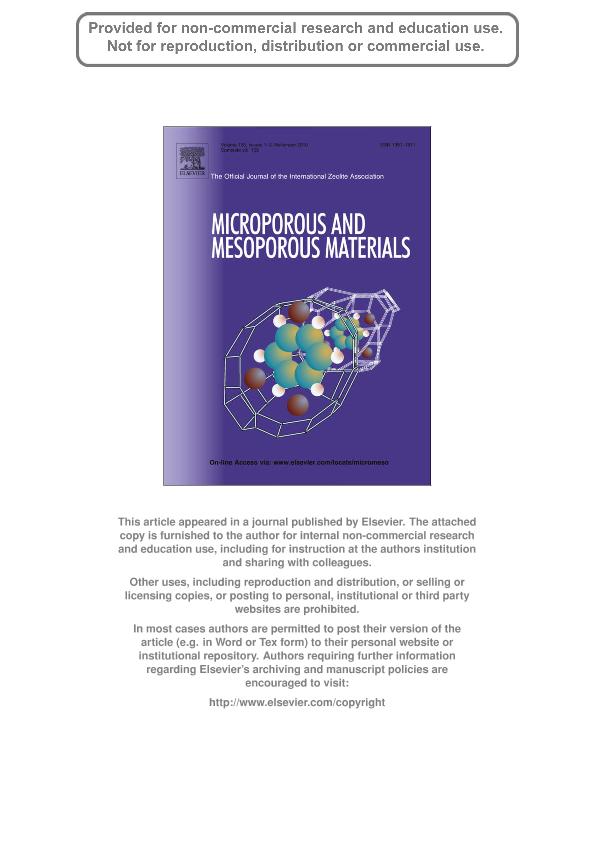Mostrar el registro sencillo del ítem
dc.contributor.author
Cecowski, Sasa
dc.contributor.author
Tusar, Natasa Novak
dc.contributor.author
Rangus, Mojca
dc.contributor.author
Mali, Gregor
dc.contributor.author
Soler Illia, Galo Juan de Avila Arturo

dc.contributor.author
Kaucic, Venceslav
dc.date.available
2020-03-05T15:11:02Z
dc.date.issued
2010-11
dc.identifier.citation
Cecowski, Sasa; Tusar, Natasa Novak; Rangus, Mojca; Mali, Gregor; Soler Illia, Galo Juan de Avila Arturo; et al.; Thin films of cubic mesoporous aluminophosphates modified by silicon and manganese; Elsevier Science; Microporous and Mesoporous Materials; 135; 1-3; 11-2010; 161-169
dc.identifier.issn
1387-1811
dc.identifier.uri
http://hdl.handle.net/11336/98835
dc.description.abstract
Mesoporous aluminophosphate thin films and xerogels with ordered three-dimensional pore arrangement, modified by silicon or silicon and manganese, were synthesized. Aluminophosphate reaction mixtures were templated with non ionic polymer surfactant Pluronic F127 and deposited as thin layers of precursor solution on Petri dishes for xerogels and on glass substrates for thin films. Surfactant removal was investigated by thermal analysis. Small Angle X-ray Scattering measurements showed that calcined silicoaluminophosphate (SAPO) and manganese silicoaluminophosphate (MnSAPO) thin films have highly ordered mesostructures, which remain stable up to at least 400°C. The mesostructures exhibit cubic symmetry described by an Im3̄m space group. Cubic mesostructure was confirmed also by TEM, SEM and AFM microscopy. Incorporation of silicon and manganese into the aluminophosphate framework was studied by solid-state NMR and X-ray absorption spectroscopy. Silicon-rich domains were detected in calcined SAPO and MnSAPO xerogels and in MnSAPO thin films. The observation of Si(OSi)3(OAl) framework units at the border of such domains suggests that acid sites might be included within silicoaluminophosphate walls. Mn3+ and Mn2+ cations are present in the MnSAPO frameworks of calcined xerogels and thin films in the molar ratio of 40%/60%. Manganese cations are coordinated to four oxygen atoms, suggesting that they are incorporated within the framework and that they can act as framework redox sites.
dc.format
application/pdf
dc.language.iso
eng
dc.publisher
Elsevier Science

dc.rights
info:eu-repo/semantics/openAccess
dc.rights.uri
https://creativecommons.org/licenses/by-nc-sa/2.5/ar/
dc.subject
AFM
dc.subject
EXAFS
dc.subject
NMR
dc.subject
SILICON AND MANGANESE MODIFIED CUBIC MESOPOROUS ALUMINOPHOSPHATE
dc.subject
THIN FILMS
dc.subject.classification
Otras Ciencias Químicas

dc.subject.classification
Ciencias Químicas

dc.subject.classification
CIENCIAS NATURALES Y EXACTAS

dc.title
Thin films of cubic mesoporous aluminophosphates modified by silicon and manganese
dc.type
info:eu-repo/semantics/article
dc.type
info:ar-repo/semantics/artículo
dc.type
info:eu-repo/semantics/publishedVersion
dc.date.updated
2020-03-04T17:34:20Z
dc.journal.volume
135
dc.journal.number
1-3
dc.journal.pagination
161-169
dc.journal.pais
Países Bajos

dc.journal.ciudad
Amsterdam
dc.description.fil
Fil: Cecowski, Sasa. National Institute Of Chemistry; Eslovenia
dc.description.fil
Fil: Tusar, Natasa Novak. National Institute Of Chemistry; Eslovenia
dc.description.fil
Fil: Rangus, Mojca. National Institute Of Chemistry; Eslovenia
dc.description.fil
Fil: Mali, Gregor. National Institute Of Chemistry; Eslovenia
dc.description.fil
Fil: Soler Illia, Galo Juan de Avila Arturo. Consejo Nacional de Investigaciones Científicas y Técnicas; Argentina. Comisión Nacional de Energía Atómica; Argentina
dc.description.fil
Fil: Kaucic, Venceslav. National Institute Of Chemistry; Eslovenia
dc.journal.title
Microporous and Mesoporous Materials

dc.relation.alternativeid
info:eu-repo/semantics/altIdentifier/url/https://www.sciencedirect.com/science/article/pii/S138718111000226X
dc.relation.alternativeid
info:eu-repo/semantics/altIdentifier/doi/http://dx.doi.org/10.1016/j.micromeso.2010.07.005
Archivos asociados
